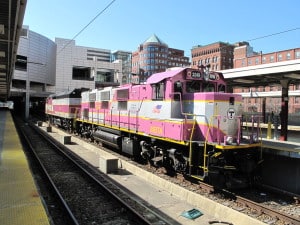A committee of elected officials, business leaders and transportation experts tasked with identifying possible improvements to the state’s commuter rail system is considering a wide range of options, from investing in new vehicles to electrifying the entire network.
After months of research, the MBTA’s Rail Vision Advisory Committee has identified seven options for improving the system. All would require significant investment, and committee members hope their work will help improve service for the public.
The panel’s work lies early in the planning phase – and the committee itself will not be responsible for the final decision – but progress is showing. The group this week discussed how the options will be analyzed with advanced modeling software to get a better sense of the impacts. In the coming months, the final findings will be presented to the public and to state leaders who will decide what, if any, changes to make.
On one end of the spectrum are ideas requiring minor investment, such as simple renovations and modernizations to tracks. On the other end are advanced, more expensive plans, such as expansions to South Station or construction of a North-South Rail Link. Each option, however, would increase the frequency of trains.
More significant ideas also suggest purchases of new train cars and partial or full electrification of the system, a move that advocates say would reduce emissions created by the current diesel fleet. All seven proposals are still being analyzed, but Scott Hamwey, manager of transit planning in the state’s Office of Transportation Planning, said at the group’s Tuesday meeting he believes “there is probably general consensus in this group that electrification is the right investment to make.”
One component among several of the alternatives is to designate certain high-ridership stops, particularly those in gateway cities, as “key stations” where trains will run more frequently.
“We knew there were stations that were well located along the regional highway system … that were likely to be better places to pull people off the highway system, out of cars commuting to Boston,” said Hamwey, who leads the Advisory Committee’s meetings.
The committee was convened in June 2018 to explore options for addressing several needs of the MBTA’s commuter rail system, such as improving service in the inner core and leveraging the trains to reduce highway congestion. Its members come from the public and private sectors, and include U.S. Reps. Katherine Clark and Seth Moulton, Lawrence Mayor Dan Rivera, former Lt. Gov. Tim Murray and former Secretary of Transportation Jim Aloisi.
With 14 lines serving 50 cities and towns, the MBTA’s commuter-rail system is one of the largest in the country. About 122,000 daily passenger trips take place on a typical weekday, according to the agency, accounting for about 9 percent of all MBTA trips. The system’s operator, Keolis Commuter Services, in 2014 beat out former system operator Massachusetts Bay Commuter Railroad Co. for a $2.69 billion eight-year commuter rail contract, the largest operating contract in state history.
In the coming months, the process will draw more involvement from the public. The committee plans to launch a digital survey and host an open house, both likely in March. Presentations to the Department of Transportation will take place in the summer, and the committee’s final report will be due by the end of the year.
MassDOT and the MBTA’s Fiscal and Management Control Board will make a final decision on investments.




 |
| 


